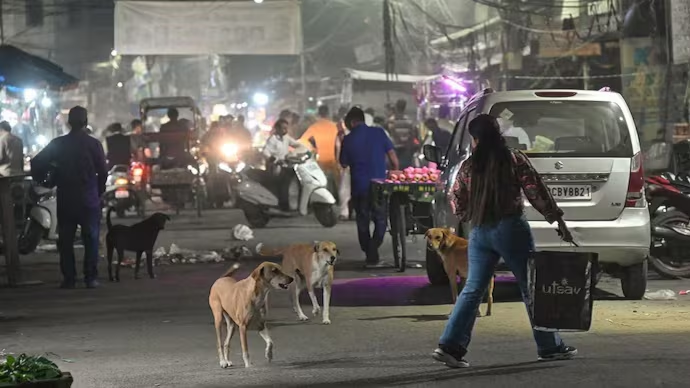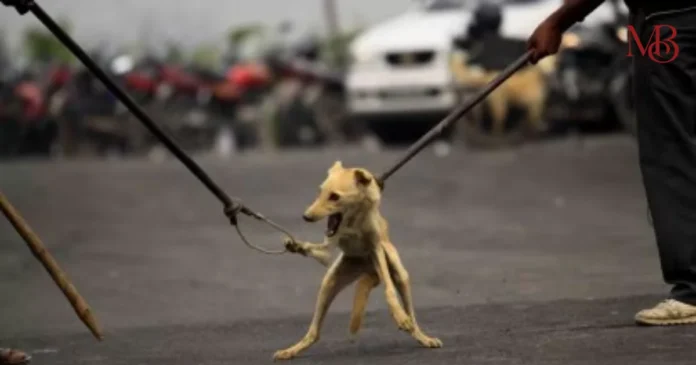On a humid August morning in Delhi, the streets near the Red Fort looked different. The usual packs of Delhi stray dogs that locals had learned to navigate around, some playful and some territorial, were nowhere to be seen. Instead, municipal vans and dog-catching teams moved from lane to lane, carrying nets and cages.

This was no routine operation. It was the beginning of one of the most sweeping crackdowns on Delhi stray dogs in the city’s history, following a Supreme Court directive that has set the city and the nation on edge.
Supreme Court Steps In on Delhi Stray Dogs
Earlier this month, the Supreme Court of India issued a directive that startled both policymakers and animal welfare activists. It stated that all Delhi stray dogs must be removed from the streets and relocated to shelters within eight weeks.
The reason was a sharp rise in dog-bite incidents, particularly those involving children. In January 2025 alone, India recorded about 430,000 dog-bite cases, compared to 3.7 million in the whole of 2024. Delhi, with an estimated 1 million stray dogs, was one of the worst affected regions.
The court emphasized that public safety was paramount and warned of strict legal consequences for anyone who obstructed the relocation drive.
Fear on the Streets Over Delhi Stray Dogs
For many residents, the ruling feels like long overdue action. Shopkeepers in Chandni Chowk recall near-misses, and parents talk about keeping children indoors after dusk.
Two weeks ago, a boy from the neighborhood was bitten outside my shop, says a grocer. His parents spent hours going from clinic to clinic for vaccines.
But for others, especially those who feed and care for Delhi stray dogs, the decision feels like an emotional blow. For them, these animals are not threats but part of the community.
Critics Call the Delhi Stray Dogs Removal Impractical and Cruel
Animal welfare experts were quick to push back, calling the order impractical and unscientific. The Animal Birth Control (ABC) Rules 2023 actually prohibit relocating Delhi stray dogs and instead require catching, sterilizing, vaccinating, and releasing them back into their original areas.
Conservationist Bahar Dutt warned that the order ignores on-ground realities. Vidit Sharma of Save A Stray argued that the city needs mass sterilization and vaccination drives, not mass removals.
Government Struggles to Manage Delhi Stray Dogs
Officials admit that Delhi simply does not have enough shelters for the sheer number of Delhi stray dogs. Legal amendments may be necessary to comply with the court order.
The Municipal Corporation of Delhi (MCD) has already begun the process, capturing around 700 Delhi stray dogs from the Red Fort area ahead of Independence Day. Removals are being carried out in phases, starting in high-density zones such as Shahdara and Bhajanpura. A helpline has also been launched for reporting aggressive dogs.
Political and Public Pushback on the Policy
Political voices like TMC MP Saket Gokhale have branded the directive cruel and inhuman, urging consultation with stakeholders.
Interestingly, even Chief Justice B R Gavai has indicated that the order might be reviewed, suggesting that the final approach could be more balanced.
Summary Table of the Delhi Stray Dogs Situation
| Aspect | Key Points |
| Supreme Court Order | Remove all Delhi stray dogs from the streets to shelters within eight weeks. |
| Main Reasoning | Surge in rabies cases and dog bites; public safety prioritized. |
| Critics Concerns | Lack of shelters, legal conflict with ABC Rules, feasibility, and humane methods. |
| Government Action | Begun capturing dogs, exploring infrastructure development, and legal amendments. |
| Judicial Review | CJI is considering reconsideration. |
| Public Pressure | Activists, MPs, and experts are demanding an inclusive, evidence-based response. |
Two Delhi Voices, Two Realities on Stray Dogs
In East Delhi, Meena Sharma, who has fed the same group of Delhi stray dogs for over six years, is heartbroken. They know me. They trust me. And now they are gone, she says.
A few streets away, Ramesh Yadav, a father of two, shares the opposite view. My daughter was bitten last year. She still cries when she sees a dog. I can finally let her walk to the shop without fear.
Both experiences are true. Both emotions are real. This is what makes the crisis so complex.

What Happens Next for Delhi Stray Dogs
If the Supreme Court holds firm, the city will need to rapidly build shelter infrastructure, likely involving NGOs and public-private partnerships.
If the order is softened, the administration may return to a scaled up ABC program, focusing on sterilization, vaccination, better waste management, and public education about Delhi stray dogs.
Also Read: Uttarkashi Flash Floods: When the Mountains Roared Back
The Larger Picture of the Delhi Stray Dogs Debate
This is more than a stray dog issue. It is a test of how Indian cities can balance human safety with compassion for animals, while also respecting the laws that govern both.
For now, the eight-week clock is ticking, and both residents and Delhi stray dogs are waiting to see which way the city turns.
FAQs on Delhi Stray Dogs
Q1. Why did the Supreme Court order the removal of Delhi stray dogs?
The order came after a sharp rise in dog-bite cases, especially involving children, and concerns over the spread of rabies.
Q2. How many Delhi stray dogs are there?
Estimates suggest there are around 1 million stray dogs in the city.
Q3. What do the ABC Rules 2023 say about Delhi stray dogs?
The rules mandate sterilization and vaccination of strays, followed by release into their original territories, not relocation.
Q4. Could the order on Delhi stray dogs be reversed or modified?
Yes, Chief Justice B R Gavai has hinted at a possible review of the directive.


